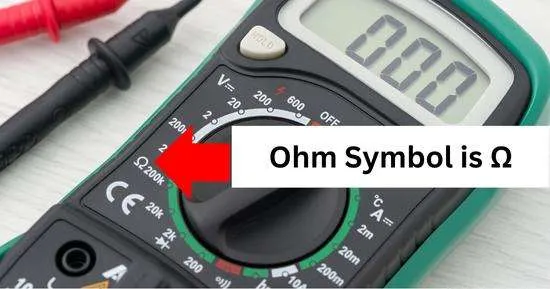When you have to measure the resistance with the help of a Multimeter, that’s why you must know about the symbol of the resistance used on the multimeter. This article will teach you about resistance, its unit, measurement through a multimeter, and “What is the symbol for ohms on your Multimeter?“.
The resistance is measured in the ohms. The scale on display is labeled as the ohm in the analog multimeter with the Ω sign. The higher value of the ohm means that there is greater resistance.
When there is higher resistance, the small current will flow. A circuit with no resistance means that there is complete resistance and is not short. The symbol of the ohm in the digital meter is omega Ω.
Table of Contents
ToggleWhat is the symbol for ohms on a multimeter?
The symbol for ohm on a multimeter is Ω(omega). Ohm is the SI unit of resistance and is represented by the omega sign(Ω). The symbol Ω used as the resistance unit comes from Georg Simon Ohm.
A multimeter can measure resistance in ranges such as 200 Ω to 2000kΩ. If your multimeter has an auto-ranging function, it will help find resistance in any range without needing to adjust the range while testing different circuits.
To select the resistance setting, rotate your multimeter to Ω sign
When you rotate the dial to the ohm sign, you can check whether your multimeter has ideal resistance (0). Connect both metal ends of your multimeter probes to each other. Resistance in multimeter probes should be zero ohms. If there is a reading above zero, you have to subtract it from the tested reading for the correct readings.
The ohmmeter is utilized to calculate the resistance as it is the common testing tool. A multimeter is a combination of an ohmmeter, voltmeter, and At the same time, the multimeter is used for measuring the resistance and the other electrical properties like current, voltage, capacitance, frequency, temperature and transistor gain, etc.
In supplying current circuits, high resistance can cause electrical issues such as overheating, fire, and damage to wires.
What is resistance?
Resistance is an opposing force against the current flowing in a circuit. Different conductors and circuits can have different amounts of resistance. Issues such as corrosion, short circuit, and damage can increase or decrease resistance in a circuit.
A good conductor has 0-ohm resistance. As the resistance increases, the conductivity of a circuit decreases. That’s why an insulator(nonconductor) has infinite resistance.
Resistance formulae are Ω=V(voltage)\A(current). As the current decreases, resistance increases.
Circuits can have different resistance ranges. Home electrical systems should have around zero resistance, while a car’s different parts can have kiloohms and megaohms.
The multimeter measures the resistance in the circuit by sending a small amount of current into it. The symbol used for the opposition is the ohm, denoted as Ω, which comes from the greek letter omega.
Resistance is not AC or DC; it is about opposing current in a wire. Within the range of selection on the multimeter, you can choose the scale for the Kilo ohm (1000 ohm )and the mega ohm (one million ohms), denoted as kΩ and MΩ.
- Ω= ohms
- kΩ= kiloohms
- MΩ=mega ohms
Kiloohms, as the name suggests, represent ohms in the range of thousands, such as 1 KΩ to 999KΩ, because 1000k is megaohms. 1 megaohm is 1000000Ω(1 million ohms)
How to measure resistance with a Multimeter
Set your multimeter to the Ω sign. Set a range of ohms above the circuit you are testing.
Connect both probes of the multimeter to both ends of the testing circuit.
Usually, a conductor or circuit with minimal resistance (near 0 ohms) is considered an excellent current-carrying path.
However, circuits designed for a specific purpose can have high resistance for optimal functioning.
However, if your multimeter reads OL, the tested circuit is incomplete.
Frequently Asked Questions
-
What does OL mean on a digital multimeter?
You will probably notice your multimeter’s OL symbol or infinite resistance. It shows no current flow in the circuit to which you are trying to measure the resistance. When the multimeter shows infinite resistance, the circuit has an incomplete path, as the current can’t return to the multimeter.
For example, you must measure the water flowing from the pipe. The clogged pipe gives more water resistance so that less water can flow through it. When the pipe is clogged completely, it will not allow the water to flow because of the high resistance.
-
How to use a multimeter to check continuity?
- Set your multimeter to continuity mode having signs of volume ‘)))‘ or ⇥. You can check continuity with the resistance mode too.
- Connect both multimeter probes to both terminals of a circuit or wires in which you want to check continuity. Continuity detects the current flow path, whether it is complete or not.
- A multimeter will pass some voltage through its battery and check whether the current flows through an entire circuit.
- If there is continuity in the tested circuit multimeter will display resistance in the circuit or make a beep sound. While in the case of discontinuity, the multimeter shows OL or 1.
-
How to test electrical wires with a multimeter?
- You can test electrical wires by testing the voltage of the circuit. Set your multimeter to DC voltage(for testing battery circuit) or AC (for home circuit), according to requirement.
- Connect the red probe to the live wire and the black probe to the ground wire. In this way, the multimeter will show you the circuit’s voltage, and damaged wires will cause low voltage in the circuit.
- You can also check electrical wires by checking their resistance. Set your multimeter to resistance and connect its probes to a wire or circuits. If your multimeter reads minimum resistance (0 ohms), the tested wire is fine; otherwise, high resistance means poor wires.
-
How to measure AC voltage using a multimeter?
- To measure voltage in an AC circuit(home supply), set your multimeter to the AC voltage sign at a range above your tested circuit.
- Usually, the home supply is 120 or 240V, so set your multimeter to 200 or 600V. The tested AC circuit connects the red probe to the live wire and the black probe to the ground wire.
- The multimeter will display the voltage of a tested circuit.
Conclusion
You will take time to understand the ins and outs of the multimeter. One of the multimeter’s essential functions is to measure a conductor’s resistance. So for this purpose, you must understand the symbol of resistance and other electrical quantities. Then after understanding, you can easily measure the resistance by following the procedure above.
Related Guides:






